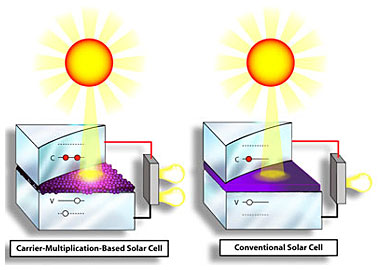LOS ALAMOS, N.M., Jan. 25, 2006 -- Los Alamos National Laboratory scientists have discovered that a phenomenon called carrier multiplication, in which semiconductor nanocrystals respond to photons by producing multiple electrons, is applicable to a broader array of materials than previously thought. The discovery increases the potential for the use of nanoscrystals as solar cell materials to produce higher electrical outputs than current solar cells.
In papers published recently in the journals Nature Physics and Applied Physics Letters, the scientists demonstrate that carrier multiplication is not unique to lead selenide nanocrystals, but also occurs with very high efficiency in nanocrystals of other compositions, such as cadmium selenide. In addition, these new results shed light on the mechanism for carrier multiplication, which likely occurs via the instantaneous photoexcitation of multiple electrons. Such a process has never been observed in macroscopic materials, and it explicitly relies on the unique physics of the nanoscale size regime.
 According to Richard Schaller, a Los Alamos scientist on the team, "Our research of carrier multiplication in previous years was really focused on analyzing the response of lead selenide nanocrystals to very short laser pulses. We discovered that the absorption of a single photon could produce two or even three excited electrons. We knew, somewhat instinctively, that carrier multiplication was probably not confined to lead selenide, but we needed to pursue the question."
According to Richard Schaller, a Los Alamos scientist on the team, "Our research of carrier multiplication in previous years was really focused on analyzing the response of lead selenide nanocrystals to very short laser pulses. We discovered that the absorption of a single photon could produce two or even three excited electrons. We knew, somewhat instinctively, that carrier multiplication was probably not confined to lead selenide, but we needed to pursue the question."
The Los Alamos findings point toward practical photovoltaic technologies that may utilize such traditional solar cell materials as cadmium telluride, which is very similar to cadmium selenide. Other interesting opportunities may also be associated with the use of carrier multiplication in solar-fuel technologies and specifically, the production of hydrogen by photo-catalytic water splitting. The latter process requires four electrons per water molecule and its efficiency can be dramatically enhanced if these multiple electrons can be produced via a single-photon absorption event.
In addition to Klimov and Schaller, the Los Alamos team includes Melissa Petruska, all of the Physical Chemistry and Applied Spectroscopy group. Research on carrier multiplication at Los Alamos is funded by the DOE's Office of Basic Energy Sciences and by Los Alamos' Laboratory-Directed Research and Development (LDRD) program.
For more information, visit: quantumdot.lanl.gov online